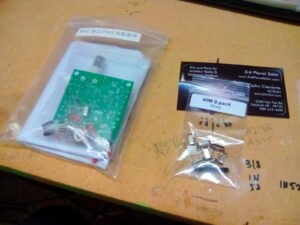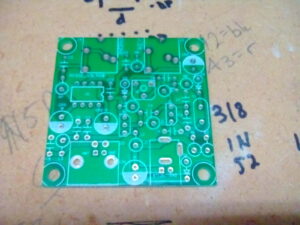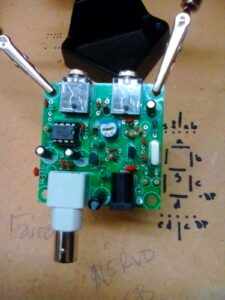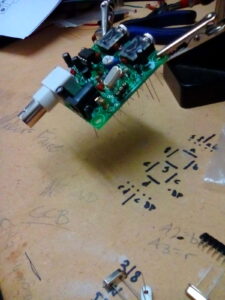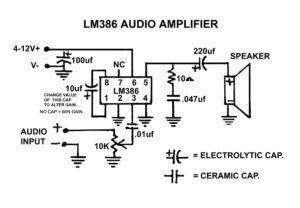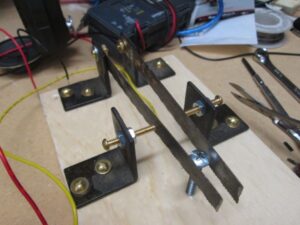On your mark… Get set… GO!!
I didn’t know what to expect from Field Day, but I was excited at the prospect of being able to tune around on HF and check out some nice radios. I got to play with a Flex Software Defined Radio (I’m not sure what model), a really real HF radio on 80 meters and 40 meters, listened to the CW station and got to see FSK digital mode in action. The other guys told me that this was a pretty tame year, which I think really worked out in my favor. I got to spend some time with the radios without feeling rushed, but still had patient and knowledgeable supervision around for guidance.
I met several people that I haven’t even seen at meetings and had some fun conversation with other new hams. I hope to run into them at the next meeting (or maybe on the air!). I had a great time and it was nice to finally get to spend time with the older guys from the club. I had to leave after just a few hours though and didn’t get to make any QSOs myself, though I did get to help another ham by logging for him.
Late night HF and CW
After the engagement that I had to leave field day for, I got to come back for the late night session. I ran into my friend Scott, KF5ZRZ, and his family and talked with them for awhile. Then I made it to the primary operations room to find just 3 hams. Milos, KA5QMA I think, was working CW and racking up points for the club, while Bob and another ham were lurking around the HF rig.
I sat with Milos for awhile and listened to the stream of morse code pouring from the rig he was stationed at. It was a simple setup. Just a radio, an iambic key and a computer for logging contacts. He was brilliant. One after another he pulled contacts from the stream and logged them. He seemed to me to be very efficient at this. We talked some between contacts and I learned that he spends quite a lot of time on HF sending and copying CW. This really lit a fire in me to practice practice practice! I want to be like Milos!!
The 2 meter and 6 meter was setup on the Flex SDR and was right next to the CW rig. So while I was talking with Milos, I was also tuning around on VHF to no avail. 6 meters was closed and 2 meters was quite. I picked up a couple late night nets, but didn’t want to interupt for a quick QSO.
Then it was finally time for HF. I’ll admit I was a little nervous. They had a base station with a lot of buttons and a big dial and boxes connected to other boxes a whole lot of stuff that I didn’t understand. But, in the spirit of Field Day and The Hobby, I dove right in. I think they had the antenna tuned up for 80m and they were operating SSB. I’ve read about both, but never tried either. Finally, here was my chance. I had watched for a little earlier in the day, so I kinda knew what was going on. I started idly tuning around the band, picking up faint signals here and there, but nothing I could really work. I tried to answer a couple of CQs, but didn’t hear back. Our NVIS antenna seemed to be having some trouble getting out. I kept tuning. Finally here comes a CQ loud and clear… so I answer, “Whiskey five kilo alpha, whiskey five kilo alpha!” I’d been running over the neumonics in my head just for this. I felt like it came out pretty confident. I suppose it did. They called back for details. Crap! What now?! I hadn’t prepared for this! The other guys saw my befuddlement and jumped in telling me to finish the contact. Oh yeah. I knew that. “Whiskey 5 kilo alpha, 3 alpha, South Texas.” I did it. I made my first contact. I was so proud. I had just gotten a logged contact for my club. Yay me!
Unfortunately, just as I was tuning this station, Val calls that she’s here to pick me up. I convinced her to wait explaining that I’d just tuned a strong station and was about to make my first contact. It only took a few minutes, so it wasn’t a big deal. But then she got to here about it all the way home while I tried to explain to her why it was so exciting. I think maybe she got it. At least a little bit. Oh well. Time for bed.
A slow finish and 6m finally opens
Asleep at 3:00 am and somehow fully awake and on my way out the door by 7:00. I guess I still had a little buzz from that late night QSO. I woke up, jumped out of bed and pulled my pants on. I was out the door in just a few minutes and heading to the American Red Cross building. When I arrived there were a few more folks there, but there still wasn’t a lot going on. Jeff, N5MNW, was back at the Flex SDR tuning around on 2m, 6m and now 15m. The CW station was no longer active, but Lew had his digital station up an running. And of course, Bob and Stuart were over at the HF station. Jeff reported that the VHF/UHF bands — particularly 6m — was still not really open, but he’d made a few contacts. I had never seen any of the digital modes operating, so I sat down with Lew, W5IFQ, for a demo and discussion. It’s pretty cool stuff and I may get into it a little bit later, but it still doesn’t hold the romance of the HF SSB for me. He told me about using it on naval ships — with his own antennas — to stay in touch with his wife via regular email. That’s pretty cool info since I don’t know if I’ll ever convince Val to get her license :-).
Now it was time to wander back over to the HF station to attempt to get our 5 QRP contacts. Stuart, K5KVH, and I both had headphones while he tuned and I logged. I had a great time tuning around with him and helping pick out the station callsigns and contest info while we tried to work the different stations that we came across.
(Post unfinished, but I wanted to post something)

